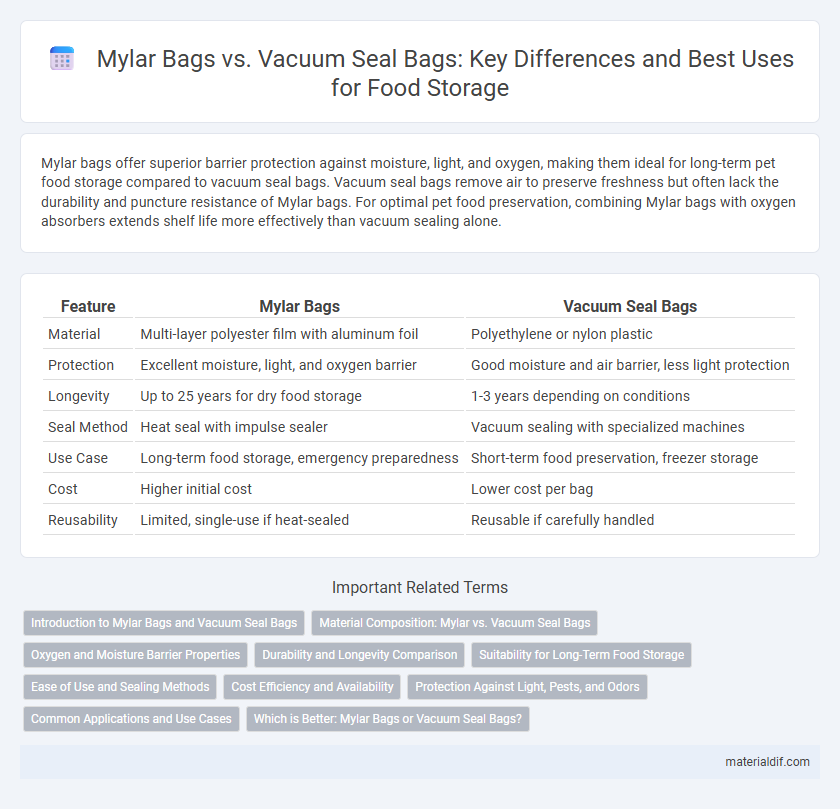Mylar bags offer superior barrier protection against moisture, light, and oxygen, making them ideal for long-term pet food storage compared to vacuum seal bags. Vacuum seal bags remove air to preserve freshness but often lack the durability and puncture resistance of Mylar bags. For optimal pet food preservation, combining Mylar bags with oxygen absorbers extends shelf life more effectively than vacuum sealing alone.
Table of Comparison
| Feature | Mylar Bags | Vacuum Seal Bags |
|---|---|---|
| Material | Multi-layer polyester film with aluminum foil | Polyethylene or nylon plastic |
| Protection | Excellent moisture, light, and oxygen barrier | Good moisture and air barrier, less light protection |
| Longevity | Up to 25 years for dry food storage | 1-3 years depending on conditions |
| Seal Method | Heat seal with impulse sealer | Vacuum sealing with specialized machines |
| Use Case | Long-term food storage, emergency preparedness | Short-term food preservation, freezer storage |
| Cost | Higher initial cost | Lower cost per bag |
| Reusability | Limited, single-use if heat-sealed | Reusable if carefully handled |
Introduction to Mylar Bags and Vacuum Seal Bags
Mylar bags, made from stretched polyester film, provide a durable barrier against moisture, oxygen, and light, making them ideal for long-term food storage and preservation. Vacuum seal bags, typically crafted from multi-layered plastic, function by removing air to create an airtight environment, extending shelf life and reducing freezer burn. Both options offer reliable protection but differ in material composition and sealing methods to suit various storage needs.
Material Composition: Mylar vs. Vacuum Seal Bags
Mylar bags are made from a metallized polyethylene terephthalate film that provides excellent barrier properties against moisture, oxygen, and light, making them ideal for long-term food storage. Vacuum seal bags are typically composed of multi-layered polyethylene and nylon, designed to withstand heat sealing and create an airtight environment but offer less protection from light compared to Mylar. The superior material composition of Mylar enhances shelf life by preventing oxidation and preserving freshness better than conventional vacuum seal bags.
Oxygen and Moisture Barrier Properties
Mylar bags provide superior oxygen and moisture barrier properties compared to vacuum seal bags, making them ideal for long-term food storage and preservation. The metallized polyester film in Mylar bags significantly reduces oxygen transmission rates and prevents moisture infiltration, which helps maintain product freshness and extends shelf life. Vacuum seal bags rely on removing air but lack the robust barrier characteristics of Mylar, resulting in less effective protection against oxygen and moisture exposure.
Durability and Longevity Comparison
Mylar bags offer superior durability compared to vacuum seal bags due to their multi-layered polyester construction, which provides exceptional resistance to punctures, moisture, and oxygen infiltration. The longevity of Mylar bags extends to several years when stored properly, making them ideal for long-term food storage and preservation. Vacuum seal bags, while effective for short-term use, typically have thinner plastic layers that may tear or degrade faster, reducing their suitability for extended storage periods.
Suitability for Long-Term Food Storage
Mylar bags offer superior protection against moisture, oxygen, and light, making them highly suitable for long-term food storage compared to vacuum seal bags. Their multi-layer metallized film blocks environmental factors that degrade food quality over time, ensuring extended shelf life. Vacuum seal bags primarily remove air but lack the robust barrier properties of Mylar, making them less effective for preserving food over extended periods.
Ease of Use and Sealing Methods
Mylar bags offer straightforward heat-sealing methods using household irons or impulse sealers, making them user-friendly for long-term storage. Vacuum seal bags require specialized vacuum sealers to remove air before sealing, which can be less convenient for occasional users. The ease of use in Mylar bags lies in their simple sealing process, while vacuum seal bags provide airtight sealing but depend on electrical equipment.
Cost Efficiency and Availability
Mylar bags typically offer greater cost efficiency due to their reusable nature and affordability in bulk purchases, making them popular for long-term storage. Vacuum seal bags often come at a higher initial cost and require a vacuum sealer device, increasing the overall expense and limiting availability for casual users. Mylar bags are widely available in various sizes and thicknesses from multiple suppliers, enhancing their accessibility compared to specialized vacuum seal bags that may have limited distribution.
Protection Against Light, Pests, and Odors
Mylar bags provide superior protection against light, pests, and odors due to their multi-layered metalized polyester construction, which creates an effective barrier against UV rays and air infiltration. Vacuum seal bags, made from flexible plastic, offer tight seals but are less effective at blocking light and preventing pests from penetrating. Mylar's durability and impermeability make it ideal for long-term storage of sensitive items prone to degradation from exposure to light and contaminants.
Common Applications and Use Cases
Mylar bags are widely used for long-term food storage, emergency preparedness, and protecting valuables from moisture, light, and oxygen, making them ideal for preserving dried foods, seeds, and documents. Vacuum seal bags are commonly utilized in everyday kitchen settings to extend the freshness of perishable items like meats, fruits, and vegetables by removing air and reducing oxidation. Both types of bags serve crucial roles in food preservation but differ in material durability and protection levels, with Mylar bags excelling in barrier properties for extended shelf life.
Which is Better: Mylar Bags or Vacuum Seal Bags?
Mylar bags offer superior protection against moisture, light, and oxygen, making them ideal for long-term storage of sensitive items like food and electronics. Vacuum seal bags excel in removing air to extend freshness but may not provide the same level of barrier against external elements as Mylar. For durability and maximum preservation, especially in extreme conditions, Mylar bags are generally considered better than vacuum seal bags.
Mylar Bags vs Vacuum Seal Bags Infographic

 materialdif.com
materialdif.com